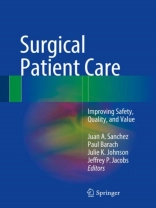This book focuses exclusively on the surgical patient and on the perioperative environment with its unique socio-technical and cultural issues. It covers preoperative, intraoperative, and postoperative processes and decision making and explores both sharp-end and latent factors contributing to harm and poor quality outcomes. It is intended to be a resource for all healthcare practitioners that interact with the surgical patient. This book provides a framework for understanding and addressing many of the organizational, technical, and cultural aspects of care to one of the most vulnerable patients in the system, the surgical patient. The first section presents foundational principles of safety science and related social science. The second exposes barriers to achieving optimal surgical outcomes and details the various errors and events that occur in the perioperative environment. The third section contains prescriptive and proactive tools and ways to eliminate errors and harm.The final section focuses on developing continuous quality improvement programs with an emphasis on safety and reliability.
Surgical Patient Care: Improving Safety, Quality and Value targets an international audience which includes all hospital, ambulatory and clinic-based operating room personnel as well as healthcare administrators and managers, directors of risk management and patient safety, health services researchers, and individuals in higher education in the health professions. It is intended to provide both fundamental knowledge and practical information for those at the front line of patient care. The increasing interest in patient safety worldwide makes this a timely global topic. As such, the content is written for an international audience and contains materials from leading international authors who have implemented many successful programs.
विषयसूची
The Burning Platform: Improving Surgical Quality and Keeping Patients Safe.- Risk Factors and Epidemiology of Surgical Safety.- Concepts and Models of Safety, Resilience, and Reliability.- Surgery through a Human Factors and Ergonomics Lens.- The Relationship between Teamwork and Patient Safety.- Enterprise and Human Factors Risk Management in Healthcare.- The Patient Experience: An Essential Component of High-Value Care and Service.- Patients and Families as Co-Producers of Safe and Reliable Outcomes.- Tools and Strategies for Continuous Quality Improvement and Patient Safety.- New Surgical Technology Implementation and Patient Safety.- Organizational Learning and Cultural Determinants of Safety.- The Role of Architecture and Physical Environment in Hospital Safety Design.- Building Surgical Expertise through the Science of Continuous Learning and Training.- Promoting Occupational Wellness and Combating Professional Burnout in the Surgical Workforce.- Executive Leadership and Surgical Quality: A Guide for Senior Hospital Leaders.- Information Technology Infrastructure, Management and Implementation: The Rise of the Emergent Clinical Information System and the Chief Medical Information Officer.- Redesigning Hospital Alarms for Reliable and Safe Care.- Implementation Science: Translating Research into Practice for Sustained Impact.- The Leadership Role: Designing Perioperative Surgical Services for Safety and Efficiency.- Operating Room Management, Measures of OR Efficiency and Cost Effectiveness.- The Science of Delivering Safe and Reliable Anesthesia Care.- Enhanced Recovery After Surgery: ERAS.- The Next Frontier: Ambulatory and Outpatient Surgical Safety and Quality.- Human Factors and Operating Room Design Challenges.- Diagnostic Error in Surgery and Surgical Services.- Preventing Perioperative ‘Never Events’.- Health Care Associated Infections in Surgical Practice.- Safer Medication Administration Through Design and Ergonomics.- Preventing Venous Thromboembolism Across the Surgical Care Continuum.- Preventing Perioperative Positioning and Equipment Injuries.- Challenges in Preventing Electrical, Thermal, and Radiation Injuries.- Improving Clinical Performance by Analyzing Surgical Skills and Operative Errors.- Perioperative Risk and Management of Surgical Patients.- Managing the Complex High-Risk Surgical Patient.- Geriatric Surgical Quality and Wellness.- Patient Transitions and Handovers across the Continuum of Surgical Care.- Failure to Rescue and Failure to Perceive Patients in Crisis.- A Quiet Revolution: Communication and Disclosing about Unexpected Outcomes and Resolving Patient Harm.- It’s My Fault: Personal Accountability and the Role of the Risk Manager in Creating Patient Safety.- Capturing, Reporting and Learning from Adverse Events.- How not to Run in Incident Investigation.- Multi-Institutional Learning and Collaboration to Improve Quality and Safety.- Lessons Learned from Anesthesia Registries about Surgical Safety and Reliability.- Use of Surgical Registry Data to Improve Outcomes.- How regulators Assess Safety and Quality in Surgical Services.- The Perioperative Surgical Home: The New Frontier.- Surgical Medical Education Program Accreditation and the Clinical Learning Environment: Patient Safety and Healthcare Quality.- Affordable Care Act, Public Legislation and Professional Self-Regulation: Implications for Public Policy.- Maintaining Surgical Safety and Quality in Rural and Remote Settings.- Global Surgery: Progress and Challenges in Surgical Quality and Patient Care.- Surgical Safety in Developing Countries: Middle East, North Africa and Gulf Countries.- Future Directions of Surgical Safety.
लेखक के बारे में
Juan A. Sanchez, MD, MPA
Associate Professor of Surgery
Johns Hopkins University School of Medicine
Chair of Surgery, Saint Agnes Hospital
900 Caton Avenue
Baltimore, MD
USA
Paul Barach, BSc, MD, MPH
Clinical Professor
Children’s Hospital of Michigan
Wayne State University School of Medicine
Detroit, MI USA
Julie K. Johnson, MSPH, Ph D
Professor
Northwestern University
Department of Surgery
Chicago, IL
USA
Jeffrey P. Jacobs, MD, FACS, FACC, FCCP
Professor of Surgery, Johns Hopkins University
Director, Andrews/Daicoff Cardiovascular Program
Surgical Director of Heart Transplantation and Extracorporeal Life Support Programs
Johns Hopkins All Children’s Heart Institute
All Children’s Hospital
Saint Petersburg, FL
USA












